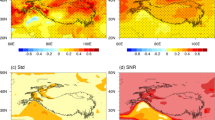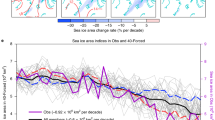Abstract
The large ensembles of the IPSL-CM6A-LR model output for the historical forcing experiment were employed to investigate the role of internal variability in the formation of the recent “warm Arctic–cold Eurasia” trend pattern in winter surface air temperature (SAT). The ensemble-mean SAT shows a positive trend over Arctic during 1990–2014, indicating a positive contribution of anthropogenic forcing to the warming Arctic. Over the region of central Eurasia, the ensemble-mean SAT trend is opposite to the observed trend. The winter SAT trends display remarkable inter-member diversity over the Barents–Kara Seas (BKS) region and central Eurasia, suggesting an important role played by internal variability. In addition to anthropogenic forcing, the results suggest that the barotropic anticyclone over northern Eurasia arising from internal variability can also contribute positively to the warming anomalies over the BKS region. On the other hand, through a fingerprint pattern matching method, it is found that the observed cooling trend over central Eurasia tends to be predominantly due to the internal variability. Finally, the results estimate that the internal variability can contribute to about 50–60% of the observed warming trend over the BKS region.











Similar content being viewed by others
References
Blackport R, Screen JA (2020) Weakened evidence for mid-latitude impacts of Arctic warming. Nat Clim Change 10:1065–1066. https://doi.org/10.1038/s41558-020-00954-y
Boucher O et al (2020) Presentation and evaluation of the IPSL-CM6A-LR climate model. J Adv Model Earth Syst 12:e2019MS002010. https://doi.org/10.1029/2019ms002010
Chen W, Yang S, Huang RH (2005) Relationship between stationary planetary wave activity and the East Asian winter monsoon. J Geophys Res Atmos 110:D14110. https://doi.org/10.1029/2004JD005669
Cheung HN, Zhou W, Shao Y, Chen W, Mok HY, Wu MC (2013) Observational climatology and characteristics of wintertime atmospheric blocking over Ural-Siberia. Clim Dyn 41:63–79. https://doi.org/10.1007/s00382-012-1587-6
Cohen JL, Furtado JC, Barlow M, Alexeev VA, Cherry JE (2012a) Asymmetric seasonal temperature trends. Geophys Res Lett 39:54–62
Cohen JL, Furtado JC, Barlow MA, Alexeev VA, Cherry JE (2012b) Arctic warming, increasing snow cover and widespread boreal winter cooling. Environ Res Lett 7:014007. https://doi.org/10.1088/1748-9326/7/1/014007
Cohen J, Jones J, Furtado J, Tziperman E (2013) Warm Arctic, cold continents: a common pattern related to Arctic Sea ice melt, snow advance, and extreme winter weather. Oceanography. https://doi.org/10.5670/oceanog.2013.70
Cohen J et al (2014) Recent Arctic amplification and extreme mid-latitude weather. Nat Geosci 7:627–637. https://doi.org/10.1038/ngeo2234
Cohen J et al (2020) Divergent consensuses on Arctic amplification influence on midlatitude severe winter weather. Nat Clim Change 10:20–29. https://doi.org/10.1038/s41558-019-0662-y
Dee DP et al (2011) The ERA-Interim reanalysis: configuration and performance of the data assimilation system. Q J R Meteorol Soc 137:553–597
Deser C, Knutti R, Solomon S, Phillips AS (2012) Communication of the role of natural variability in future North American climate. Nat Clim Change 2:775–779. https://doi.org/10.1038/nclimate1562
Deser C, Phillips AS, Alexander MA, Smoliak BV (2014) Projecting North American climate over the next 50 years: uncertainty due to internal variability. J Clim 27:2271–2296. https://doi.org/10.1175/jcli-d-13-00451.1
Deser C, Terray L, Phillips AS (2016) Forced and internal components of winter air temperature trends over North America during the past 50 years: mechanisms and implications. J Clim 29:2237–2258. https://doi.org/10.1175/jcli-d-15-0304.1
Ding Q et al (2019) Fingerprints of internal drivers of Arctic sea ice loss in observations and model simulations. Nat Geosci 12:28–33. https://doi.org/10.1038/s41561-018-0256-8
Eyring V, Bony S, Meehl GA, Senior CA, Stevens B, Stouffer RJ, Taylor KE (2016) Overview of the coupled model intercomparison project phase 6 (CMIP6) experimental design and organization. Geosci Model Dev 9:1937–1958. https://doi.org/10.5194/gmd-9-1937-2016
Feng C, Wu B (2015) Enhancement of winter Arctic warming by the Siberian high over the past decade. Atmos Ocean Sci Lett 8:257–263
Gillett et al (2008) Attribution of polar warming to human influence. Nat Geosci 1:750–754
Gong T, Feldstein S, Lee S (2017) the role of downward infrared radiation in the recent Arctic winter warming trend. J Clim 30:4937–4949. https://doi.org/10.1175/jcli-d-16-0180.1
Honda M, Inoue J, Yamane S (2009) Influence of low Arctic sea-ice minima on anomalously cold Eurasian winters. Geophys Res Lett. https://doi.org/10.1029/2008gl037079
Hu K, Huang G, Xie S-P (2019) Assessing the internal variability in multi-decadal trends of summer surface air temperature over East Asia with a large ensemble of GCM simulations. Clim Dyn 52:6229–6242. https://doi.org/10.1007/s00382-018-4503-x
Inoue J, Hori ME, Takaya K (2012) The role of Barents Sea ice in the wintertime cyclone track and emergence of a warm-Arctic cold-Siberian anomaly. J Clim 25:2561–2568. https://doi.org/10.1175/jcli-d-11-00449.1
Jeong J-H, Ou T, Linderholm HW, Kim B-M, Kim S-J, Kug J-S, Chen D (2011) Recent recovery of the Siberian high intensity. J Geophys Res Atmos 116:D23102. https://doi.org/10.1029/2011jd015904
Johannessen OM et al (2004) Arctic climate change – observed and modeled temperature and sea ice. Tellus 56:328–341
Kang SM, Deser C, Polvani LM (2013) Uncertainty in climate change projections of the Hadley circulation: the role of internal variability. J Clim 26:7541–7554. https://doi.org/10.1175/jcli-d-12-00788.1
Kug J-S, Jeong J-H, Jang Y-S, Kim B-M, Folland CK, Min S-K, Son S-W (2015) Two distinct influences of Arctic warming on cold winters over North America and East Asia. Nat Geosci 8:759–762. https://doi.org/10.1038/ngeo2517
Liu J, Curry JA, Wang H, Song M, Horton RM (2012) Impact of declining Arctic sea ice on winter snowfall. Proc Natl Acad Sci USA 109:4074–4079. https://doi.org/10.1073/pnas.1114910109
Luo D, Yao Y, Dai A, Simmonds I, Zhong L (2017) Increased quasi stationarity and persistence of winter Ural blocking and eurasian extreme cold events in response to Arctic warming. Part II: A theoretical explanation. J Clim 30:3569–3587. https://doi.org/10.1175/jcli-d-16-0262.1
Mori M, Watanabe M, Shiogama H, Inoue J, Kimoto M (2014) Robust Arctic sea-ice influence on the frequent Eurasian cold winters in past decades. Nat Geosci 7:869–873. https://doi.org/10.1038/ngeo2277
Mori M, Kosaka Y, Watanabe M, Nakamura H, Kimoto M (2019) A reconciled estimate of the influence of Arctic sea-ice loss on recent Eurasian cooling. Nat Clim Change 9:123–129. https://doi.org/10.1038/s41558-018-0379-3
Nakamura T, Yamazaki K, Iwamoto K, Honda M, Miyoshi Y, Ogawa Y, Ukita J (2015) A negative phase shift of the winter AO/NAO due to the recent Arctic sea-ice reduction in late autumn. J Geophys Res Atmos 120:3209–3227
North GR, Bell TL, Cahalan RF, Moeng FJ (1982) Sampling errors in the estimation of empirical orthogonal functions. Mon Weather Rev 110:699–706. https://doi.org/10.1175/1520-0493(1982)110%3c0699:Seiteo%3e2.0.Co;2
Overland JE, Wood KR, Wang M (2010) Warm Arctic—cold continents: climate impacts of the newly open Arctic Sea. Polar Res 30:15787
Park DSR, Lee S, Feldstein SB (2015) Attribution of the recent winter sea ice decline over the Atlantic sector of the Arctic Ocean. J Clim 28:4027–4033
Polyakov IV et al (2002) Observationally based assessment of polar amplification of global warming. Geophys Res Lett 29:25-21-25–24. https://doi.org/10.1029/2001gl011111
Screen JA, Blackport R (2019) Is sea-ice-driven Eurasian cooling too weak in models? Nat Clim Change 9:934–936. https://doi.org/10.1038/s41558-019-0635-1
Screen JA, Simmonds I (2010a) The central role of diminishing sea ice in recent Arctic temperature amplification. Nature 464:1334–1337. https://doi.org/10.1038/nature09051
Screen JA, Simmonds I (2010b) Increasing fall-winter energy loss from the Arctic Ocean and its role in Arctic temperature amplification. Geophys Res Lett 37:L16797. https://doi.org/10.1029/2010gl044136
Serreze MC, Barry RG (2011) Processes and impacts of Arctic amplification: a research synthesis. Global Planet Change 77:85–96. https://doi.org/10.1016/j.gloplacha.2011.03.004
Serreze MC, Barrett AP, Stroeve JC, Kindig DN (2008) The emergence of surface-based Arctic amplification. Cryosphere 3:11–19
Stroeve et al (2012) The Arctic’s rapidly shrinking sea ice cover: a research synthesis. Clim Change 110:1005–1027
Sun L, Perlwitz J, Hoerling M (2016) What caused the recent “warm Arctic, cold continents” trend pattern in winter temperatures? Geophys Res Lett 43:5345–5352. https://doi.org/10.1002/2016gl069024
Tang Q, Zhang X, Yang X, Francis JA (2013) Cold winter extremes in northern continents linked to Arctic sea ice loss. Environ Res Lett 8:014036. https://doi.org/10.1088/1748-9326/8/1/014036
Thompson DWJ, Wallace JM (2001) Regional climate impacts of the northern Hemisphere annular mode. Science 293:85–89. https://doi.org/10.1126/science.1058958
Trenberth KE, Fasullo JT, Branstator G, Phillips AS (2014) Seasonal aspects of the recent pause in surface warming. Nat Clim Change 4:911–916. https://doi.org/10.1038/nclimate2341
Vargas Zeppetello LR, Donohoe A, Battisti DS (2019) Does surface temperature respond to or determine downwelling longwave radiation? Geophys Res Lett 46:2781–2789. https://doi.org/10.1029/2019GL082220
Wang L, Chen W (2013) The East Asian winter monsoon: re-amplification in the mid-2000s. Chin Sci Bull 59:430–436. https://doi.org/10.1007/s11434-013-0029-0
Wang L, Deng A, Huang R (2018) Wintertime internal climate variability over Eurasia in the CESM large ensemble. Clim Dyn 52:6735–6748
Wang S, Chen W, Chen S, Nath D, Wang L (2020a) Anomalous winter moisture transport associated with the recent surface warming over the Barents-Kara seas region since the mid-2000s. Int J Climatol 40:2497–2505. https://doi.org/10.1002/joc.6337
Wang S, Nath D, Chen W, Wang L (2020b) Changes in winter stationary wave activity during weak mid-latitude and Arctic thermal contrast period. Int J Climatol 40:1755–1768. https://doi.org/10.1002/joc.6299
Wang S, Nath D, Chen W, Ma T (2020c) CMIP5 model simulations of warm Arctic-cold Eurasia pattern in winter surface air temperature anomalies. Clim Dyn 54:4499–4513. https://doi.org/10.1007/s00382-020-05241-2
Wang S, Nath D, Chen W (2021) Nonstationary relationship between sea ice over Kara–Laptev seas during August–September and Ural blocking in the following winter. Int J Climatol 1:1608–1622. https://doi.org/10.1002/joc.6794
Warner JL, Screen JA, Scaife AA (2020) Links between Barents-Kara sea ice and the extratropical atmospheric circulation explained by internal variability and tropical forcing. Geophys Res Lett 47:e2019GL085679. https://doi.org/10.1029/2019gl085679
Woods C, Caballero R (2016) The role of moist intrusions in winter Arctic warming and sea ice decline. J Clim 29:4473–4485
Woods C, Caballero R, Svensson G (2013) Large-scale circulation associated with moisture intrusions into the Arctic during winter. Geophys Res Lett 40:4717–4721. https://doi.org/10.1002/grl.50912
Wu B, Su J, Zhang R (2011) Effects of autumn-winter Arctic sea ice on winter Siberian High. Chin Sci Bull 56:3220. https://doi.org/10.1007/s11434-011-4696-4
Yao Y, Luo D, Dai A, Simmonds I (2017) Increased quasi stationarity and persistence of winter Ural blocking and Eurasian Extreme cold events in response to Arctic warming. Part I: Insights from observational analyses. J Clim 30:3549–3568. https://doi.org/10.1175/jcli-d-16-0261.1
Zappa G, Ceppi P, Shepherd TG (2021) Eurasian cooling in response to Arctic sea-ice loss is not proved by maximum covariance analysis. Nat Clim Change 11:106–108. https://doi.org/10.1038/s41558-020-00982-8
Zhang P, Wu Y, Simpson IR, Smith KL, Zhang X, De B, Callaghan P (2018) A stratospheric pathway linking a colder Siberia to Barents-Kara Sea sea ice loss. Sci Adv 4:eaat6025. https://doi.org/10.1126/sciadv.aat6025
Acknowledgements
The authors are grateful to two anonymous referees for their constructive comments. This study was supported jointly by the National Natural Science Foundation of China (Grants 41721004 and 41975051), the Chinese Academy of Sciences Key Research Program of Frontier Sciences (QYZDY-SSW-DQC024), and the Jiangsu Collaborative Innovation Center for Climate Change.
Author information
Authors and Affiliations
Corresponding author
Ethics declarations
Conflict of interest
The authors declare no potential conflict of interest.
Additional information
Publisher's Note
Springer Nature remains neutral with regard to jurisdictional claims in published maps and institutional affiliations.
Rights and permissions
About this article
Cite this article
Wang, S., Chen, W. Impact of internal variability on recent opposite trends in wintertime temperature over the Barents–Kara Seas and central Eurasia. Clim Dyn 58, 2941–2956 (2022). https://doi.org/10.1007/s00382-021-06077-0
Received:
Accepted:
Published:
Issue Date:
DOI: https://doi.org/10.1007/s00382-021-06077-0




